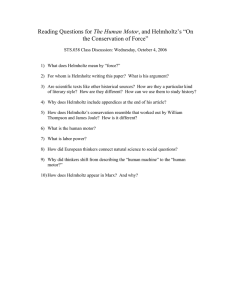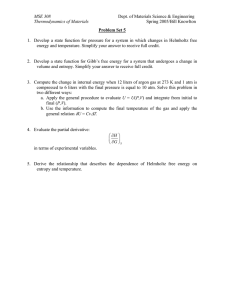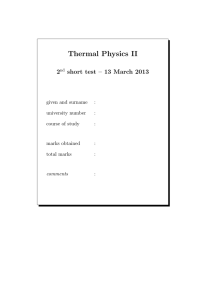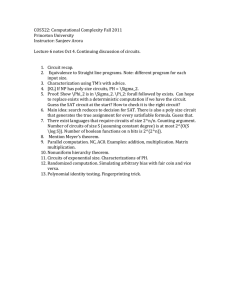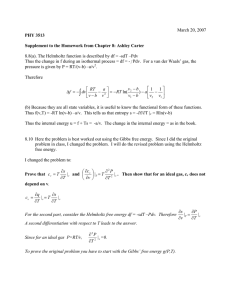Origins of the Equivalent Circuit Concept
advertisement
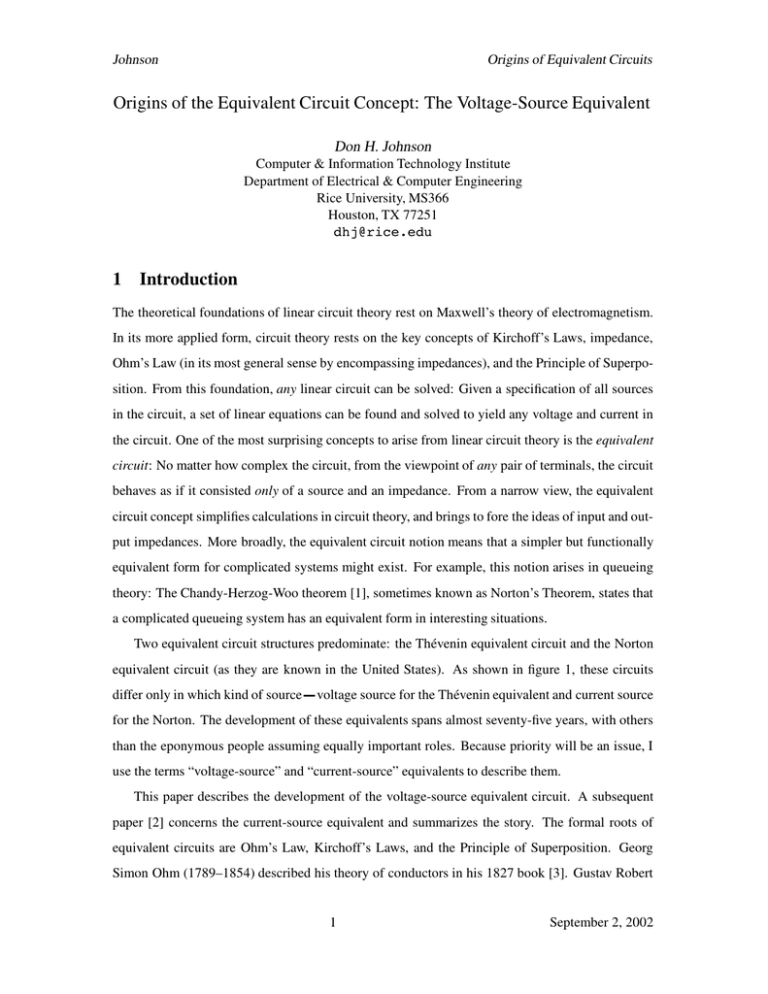
Johnson Origins of Equivalent Circuits Origins of the Equivalent Circuit Concept: The Voltage-Source Equivalent Don H. Johnson Computer & Information Technology Institute Department of Electrical & Computer Engineering Rice University, MS366 Houston, TX 77251 dhj@rice.edu 1 Introduction The theoretical foundations of linear circuit theory rest on Maxwell’s theory of electromagnetism. In its more applied form, circuit theory rests on the key concepts of Kirchoff’s Laws, impedance, Ohm’s Law (in its most general sense by encompassing impedances), and the Principle of Superposition. From this foundation, any linear circuit can be solved: Given a specification of all sources in the circuit, a set of linear equations can be found and solved to yield any voltage and current in the circuit. One of the most surprising concepts to arise from linear circuit theory is the equivalent circuit: No matter how complex the circuit, from the viewpoint of any pair of terminals, the circuit behaves as if it consisted only of a source and an impedance. From a narrow view, the equivalent circuit concept simplifies calculations in circuit theory, and brings to fore the ideas of input and output impedances. More broadly, the equivalent circuit notion means that a simpler but functionally equivalent form for complicated systems might exist. For example, this notion arises in queueing theory: The Chandy-Herzog-Woo theorem [1], sometimes known as Norton’s Theorem, states that a complicated queueing system has an equivalent form in interesting situations. Two equivalent circuit structures predominate: the Thévenin equivalent circuit and the Norton equivalent circuit (as they are known in the United States). As shown in figure 1, these circuits differ only in which kind of source voltage source for the Thévenin equivalent and current source for the Norton. The development of these equivalents spans almost seventy-five years, with others than the eponymous people assuming equally important roles. Because priority will be an issue, I use the terms “voltage-source” and “current-source” equivalents to describe them. This paper describes the development of the voltage-source equivalent circuit. A subsequent paper [2] concerns the current-source equivalent and summarizes the story. The formal roots of equivalent circuits are Ohm’s Law, Kirchoff’s Laws, and the Principle of Superposition. Georg Simon Ohm (1789–1854) described his theory of conductors in his 1827 book [3]. Gustav Robert 1 September 2, 2002 Johnson Origins of Equivalent Circuits I Sources and Linear Elements + V – I I + + Zeq Veq + V – Ieq Zeq – Thévenin Equivalent V – Norton Equivalent Figure 1: Thévenin’s (voltage-source) equivalent circuit is shown at the left and Norton’s (currentsource) equivalent circuit at the right. The impedance eq is the same in both cases and the source values are related to each other by eq eq eq . Kirchoff (1824–1887) described what have since become known as his laws in the 1840s. The Principle of Superposition was first clearly proclaimed by Hermann von Helmholtz (1821–1894) in his 1853 paper [4], in which he credits the result to his friend Émil du Bois-Reymond (1818–1896). In the same paper, Helmholtz derives the voltage source equivalent, and illustrates its application. Thirty years later, Léon Charles Thévenin (1857–1926), an engineer working for France’s Postes et Télégraphes, published the same result [5, 6] apparently unaware of Helmholtz’s work. 2 Helmholtz Helmholtz was one of the nineteenth century’s great scientists. Margeneau [8] describes him as “one of the last great universalists of science.” His life is well documented; a detailed [9, 10] and numerous short biographies [11, for example] have been published, and his works have been collected [12]. He started his scientific career in electrophysiology. During his life, he refined the concept of the conservation of energy, invented the ophthalmoscope, brought physics and mathematics to the previously qualitative fields of physiological acoustics and optics, worked in hydrodymanics and electromagnetics, derived the wave equation that bears his name, and developed ideas in the philosophy of science. In 1853, Helmholtz was Associate Professor of Physiology at Königsburg. His 1853 publication Some laws concerning the distribution of electric currents in 2 September 2, 2002 Johnson Origins of Equivalent Circuits Hermann von Helmholtz Léon Charles Thévenin 1821–1894 1857–1926 Figure 2: Undated Helmholtz photograph taken late in his life. Thévenin’s comes from the Suchet biography [7] and is also undated. conductors with applications to experiments on animal electricity in Poggendorf’s Annalen elaborated his note published the previous year [13]. In this paper, Helmholtz was concerned with determining from measurements of currents and voltages in muscle tissue the location of voltage sources (electromotive force generators) and the resulting current distribution. He described how the recent work of Kirchoff, Gauss, Ohm and others can help determine how what was then termed “animal electricity” flows. One of our primary characters, Hans Ferdinand Mayer, wrote a letter in 1950 [14] to the editor of Electrical Engineering, the non-technical publication of the AIEE. He was responding to a biography of Léon Thévenin that had been written the previous year in the same journal. He describes well Helmholtz’s derivation; I provide Mayer’s letter in full. With reference to the article “Leon Charles Thévenin” (EE, Oct ‘49, p 843–4), I would like to point out that the “Thévenin theorem” was published as early as 1853 by H. Helmholtz in Poggendorf’s Amalen [sic] der Physik und Chemie (page 211), four years before Thévenin was born. On page 212 he first formulates the principle of superposition: If any system of conductors contains electromotive forces at various locations, the voltage (potential) at any point will be equal to the algebraic sum of the voltages (potentials), which any one of the electromotive forces would produce at this point independent of the others. [Helmholtz’s and Mayer’s italics] 3 September 2, 2002 Johnson Origins of Equivalent Circuits Then he considers the case, where any two points of such a system (output terminals) are bridged by another conductor (load). He states, page 222, that no matter how complicated the system may be, it will behave with respect to the load as one single conductor of resistance, as calculated between these two points by Kirchof’s rules, in series with an electromotive force, equal to the voltage between these two points before inserting the load. On page 223, he illustrates his theorem by the simple example (see Figure 3), where the system consists of two linear (lumped) conductors of resistance ¼ and ½, in series with an electromotive source . He then points out that, according to his theorem, the system with respect to a load ¾ can be replaced by an equivalent source, having the electromotive force ½ ¼ ½ and the interior resistance ¼ ½ ¼ ½ and consequently will drive a current in ¾ ¾ ¾ In my opinion, this is a very clear formulation of what is now called “Thévenin’s theorem.” Helmholtz not only considered the case of a system of “linear conductors” (lumped resistance) but also the general case of a space, filled with resistive material of different conductivity, and electromotive forces acting on the resistive medium (distributed resistances). He then states, that if any two points at the surface of this space are connected by a load resistance, one can always replace the space by one lumped resistance in series with an electromotive force, and that this equivalent source will always drive the same current into the load as would the actual space source [italicized in Helmholtz’s original publication, but not in Mayer’s letter]. I personally have no objection to calling this theorem “Thévenin’s theorem,” although it is called “Helmholtz’s theorem” in other countries, but it is quite interesting that it was considered “new” in 1883, 30 years after Helmholtz’s publication. H.F. Mayer Professor, School of Electrical Engineering, Cornell University, Ithaca N.Y. w0 A w1 w2 Figure 3: Redrawn replica of Mayer’s figure (not present in Helmholtz’s article) to help explain Helmholtz’s derivation. 4 September 2, 2002 Johnson Origins of Equivalent Circuits Mayer’s summary implies little reasoning behind the basic result. In fact, Helmholtz used sophisticated mathematical and physical arguments to derive the result as well as ways of modeling current distributions in a distributed conductor such as muscle. Though Thévenin was unaware of Helmholtz’s result, others were not. Mayer of course knew of it in detail, and Wallot [15] references it in his 1932 German textbook. A description of Helmholtz’s paper appears as a footnote on page 145 of the MIT course notes published in 1940 [16]. 3 Thévenin Biographies about Thévenin were published in 1926 [17], the year of his death, and again in 1949 [7]. Léon Charles Thévenin was born in Meaux, France (located some twenty miles from Paris) on March 30, 1857. He graduated from the École Polytechnique in 1876 (the year the telephone was developed by Bell) and, in 1878, joined the France’s national electrical communication company Postes et Télégraphes, where he spent all of his career. He retired in 1914 to his family home in Meaux, and died in Paris on September 21, 1926, two months before the publication of the current-source equivalent. In 1882, he was appointed to teach courses for training inspectors in the engineering department because of his credentials (he successfully passed license examinations in mathematics and physical sciences upon graduation from the Polytechnique) and his apparent interest in teaching. In developing and teaching his courses, he found novel ways of explaining known results and new techniques as well, the equivalent circuit being one of them. The year 1883 marked publication of at least four papers [5, 18–20] in Annales Télégraphiques, the second of which [5] described what he thought was his new equivalent circuit result. Excited by his result, Thévenin wanted to report it to the French Academy of Sciences. According to Suchet [7], Thévenin asked a colleague, the mathematical physicist Aimée Vaschy (1857–1899), to comment on the paper. Vaschy thought the result incorrect. Thévenin consulted others, and varied opinions were offered. Eventually his previously published paper [5] was published virtually verbatim1 in Compte Rendu [6] in the same year. The following translation of Thévenin’s paper shows that he used an elegant approach to prove his theorem. ELECTRICITY. On a new theorem of dynamic electricity Note by Mr. L. Thévenin 1 The only difference is the footnote appears in the text in the Annales Télégraphiques version. 5 September 2, 2002 Johnson Origins of Equivalent Circuits Theorem. Assuming any system of linear interconnected (½) conductors, and containing some electromotive forces ½ , ¾ Ò distributed in any way, one considers two points and ¼ belonging to the system and actually having the potentials and ¼. If the points and ¼ are connected by a wire ¼ having resistance , not having an electromotive force, the potentials at the points and ¼ take on different values of and ¼ , but the current flowing in the wire is given by the formula ÎÖ ·ÎÊ , in which represents the resistance of the primitive system, measured between the points and ¼ considered as electrodes [Thévenin’s italics]. Thus, Ohm’s law applies, not only to simple electric motor circuits that have welldefined poles, like a battery or a DC machine, but to any network of conductors that one would consider such as an electric motor at arbitrary poles, given that the electromotive force is, in each case, equal to the pre-existing [Thévenin’s italics] potential difference at two points chosen for poles. This rule, which has not been mentioned before today [italics not present in the original], is very useful in certain theoretical calculations. From a practical viewpoint, it permits immediate evaluation, by two easily obtained experimental means, of the current that flows in a given branch attached to any network of conductors, without being otherwise preoccupied with the detailed constitution of the network. To show the theorem, we suppose that one introduces in the conductor ¼ an electromotive force , equal and opposite to the potential difference ¼ . Clearly, no other current flows through the conductor ¼ . Thus, the system of electromotive forces , ½ , ¾ Ò give instead a new distribution of currents, among which is one where the current through ¼ is null. We suppose now that, in the same conductor, one introduces, at the same time with ¼ the first, a second electromotive force , equal to the potential difference and in the same sense. By virtue of the principle of the independence of simultaneous electromotive forces, the force gives birth to a new current distribution, that simply superimposes in the preceding one. Among these new currents, the one flowing through the conductor ¼ is precisely the sought current , because the effect of the forces and , equal and opposite, cancel each other. The resulting current is only ¼, whose consequence is in the branch , one can, by due to the force Î Î . Moreover, calling a certain resistance, write, according to Ohm’s Law, Ö·Ê the significance of the quantity immediately appears; it is the resistance of a wire that can replace the primitive network of conductors between the points and ¼ , without the undisturbed flow due to a constant electrical source that would exist in the branch before it was modified. The quantity has a precise physical significance, and one can call it the resistance of the primitive network measured between the points and ¼ considered like electrodes. The statement of the theorem results immediately from this definition. ¼ ¼ (½ )In such a way that the end of each is connected to at least a second conductor. Figure 4 may help the reader understand what Thévenin’s model was. Thévenin’s derivation is correct, and certainly provides more engineering insight than Helmholtz’s physics-based approach. The history of Bell Labs claims that one its employees Hammond Hayes realized in 1885 that 6 September 2, 2002 Johnson Origins of Equivalent Circuits i A R V-V’ + r – A’ Figure 4: Circuit derived from Thévenin’s proof of his theorem. No figure appears in his short paper. important theoretical work in electrical systems was being done in Europe, and that “advancement[s] in electrical theory abroad . . . undoubtedly came to Hayes’ attention.” [21, p. 888] That history lists Thévenin’s result as one of those advancements. Despite Vaschy’s initial reaction, he played an important role in making Thévenin’s result widely known. In 1890, Vaschy published Traité d’Électricité et de Magnétisme [22], a well-written, definitive, two-volume treatise on theoretical and applied electromagnetism. On page 153 of Volume I he presents Thévenin’s theorem much as Thévenin had in his paper, associates his name with it, and references both of Thévenin’s 1883 papers; Vaschy does not mention Helmholtz. Also note that Helmholtz was alive when Thévenin’s paper appeared and when Vaschy’s treatise was published. In the 1940 edition of the circuit-theory text written by Timbie and Bush [23], the authors state on page 40 that This general theorem was originally proposed by Thévenin in 1883, but it has not been in general use until recently. However, the engineers of the American Telephone and Telegraph Company have used it since about 1904. Indeed, as late as 1926, Thévenin’s and Helmholtz’s result was not generally known. In that year, a physicist at the National Bureau of Standards rederived it [24].2 Thévenin’s theorem was described in the Electrical Engineers’ Handbook published in 1936 [25]. 4 Continuing the story In the next paper [2], I describe the development of the current-source equivalent. Interestingly, Hans Ferdinand Mayer, the Cornell faculty member I have quoted here on Helmholtz’s work, plays a key role. 2 Interestingly, this paper references Helmholtz’s work [4] for the superposition principle. Wenner apparently did not read 10 pages further or did not understand Helmholtz’s result. 7 September 2, 2002 Johnson Origins of Equivalent Circuits Acknowledgements Peter Schultz of the Language Resource Program, Rice University, provided assistance with German translations. References [1] K.M. Chandy, U. Herzog, and L. Woo. Parametric analysis of queueing networks. IBM J. Res. Develop., 19:36–42, 1975. [2] D.H. Johnson. Origins of the equivalent circuit concept: The current-source equivalent. Proc. IEEE, 2002. [3] G.S. Ohm. Die galvanische Kette, mathematisch bearbeitet [A mathematical theory of galvanic circuits]. 1827. [4] H. Helmholtz. II. Uber einige Gesetze der Vertheilung elektrischer Ströme in körperlichen Leitern mit Anwendung auf die thierisch-elektrischen Versuche [Some laws concerning the distribution of electrical currents in conductors with applications to experiments on animal electricity]. Annalen der Physik und Chemie, 89(6):211–233, 1853. [5] L. Thévenin. Extension de la loi d’Ohm aux circuits électromoteurs complexes [Extension of Ohm’s law to complex electromotive circuits]. Annales Télégraphiques, 10:222–224, 1883. Troisieme série. [6] L. Thévenin. Sur un nouveau théorème d’électricité dynamique [On a new theorem of dynamic electricity]. C. R. des Séances de l’Académie des Sciences, 97:159–161, 1883. [7] C. Suchet. Léon Charles Thévenin. Electrical Engineeering, 68(10):843–844, October 1949. [8] H. Margeneau. Introduction. In On the Sensation of Tones by Hermann von Helmholtz. Dover Press, 1954. [9] L. Koenigsberger. Hermann von Helmholtz. F. Vieweg and Son, Brunswick, 1902–03. Three volumes. [10] L. Koenigsberger. Hermann von Helmholtz. Clarendon Press, Oxford, 1906. Abridged translation by F.A. Welby. 8 September 2, 2002 Johnson Origins of Equivalent Circuits [11] R.S. Turner. Helmholtz, Hermann von. In C.C. Gillispie, editor, Dictionary of Scientific Biography, volume VI. Charles Scribner’s Sons, New York, 1972. [12] H. Helmholtz. Wissenschaftliche Abhandlungen. J. Barth, Leipzig, 1970. [13] H. Helmholtz. Ein Theorem über die Vertheilung elektrischer Ströme in körperlischen Leitern [A theorem concerning the distribution of electrical currents in conductors]. Monatsber. der Königlich Preuss. Akad. der Wiss. zu Berlin, 22 July 1852. [14] H.F. Mayer. Léon Charles Thévenin. Electrical Engineering, 69(2):186, February 1950. [15] J. Wallot. Einführung in die Theorie der Schwachstromtechnik. Springer-Verlag, Berlin, 1932. [16] Department of Electrical Engineering. Electric Circuits. The Technology Press, MIT, 1940. [17] H. Thomas. Léon Thévenin. Annales des Postes, Télégraphes et Téléphones, 15:1090–1098, 1926. [18] L. Thévenin. Sur la mesure de la résistance spécifique des fils [On measuring the specific resistance of wire]. Annales Télégraphiques, 10:167–178, 1883. Troisieme série. [19] L. Thévenin. Sur les conditions de sensibilité du pont de Wheatstone [On the sensitivity conditions of the Wheatsone bridge]. Annales Télégraphiques, 10:225–234, 1883. Troisieme série. [20] L. Thévenin. Sur la mesure des différences de potentiel au moyen du galvanomètre [On measuring the potential difference by galvanometers]. Annales Télégraphiques, 10:446–449, 1883. Troisieme série. [21] M.D. Fagen, editor. A History of Engineering and Science in the Bell System: The Early Years (1875–1925), volume 1. AT&T Bell Laboratories, 1985. [22] A. Vaschy. Traité d’Électricité et de Magnétisme. Maison a Liège, 1890. [23] W.H. Timbie and V. Bush. Principles of Electrical Engineering. John Wiley & Sons, Inc., New York, third edition, 1940. [24] F. Wenner. A principle governing the distribution of current in systems of linear conductors. In Scientific Papers of the Bureau of Standards, volume 21, pages 191–208. US Government Printing Office, 1926. Paper 531. 9 September 2, 2002 Johnson Origins of Equivalent Circuits [25] H. Pender and K. McIlwain, editors. Electrical Engineers’ Handbook. John Wiley & Sons, Inc, New York, 1936. 10 September 2, 2002
